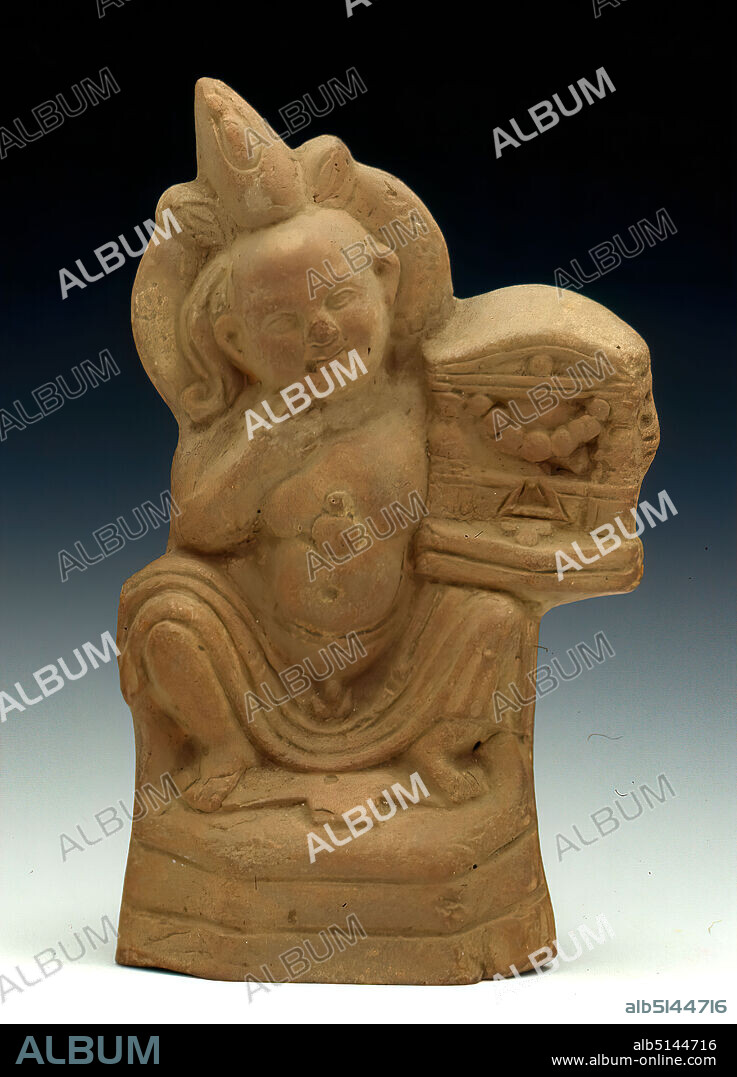alb5144716
Harpocrates with temple shrine, clay, pressed into the form, hand-modeled, fired (ceramic), clay, Total: Height: 14.4 cm; Width: 9.4 cm; Depth: 5 cm, Pottery, Egyptian gods, demigods, heroes, Harpocrates, seated figure, Early Imperial period, Middle Imperial period, Late Imperial period, The childlike, corpulent harpocrates with youth curl is enthroned on a profiled hexagonal base with a blanket With his left hand he holds a small temple shrine placed on his knee. He has led his right index finger to his mouth in a gesture typical of the god. He is naked except for a cloth laid over his thighs, which leaves his thick belly and penis free. On his chest lies a so-called heart amulet. The skull is decorated with a wreath and the double crown flanked by two buds. Harpocrates, Horus as a child, is the most favored figure among the Greco-Roman terracottas besides the goddess Isis. The depictions have undergone a thorough Hellenization, whereby native Egyptian features are always connected with Greek ones. The shaven head with horus curl is Egyptian. The temple shrine is - as the comparisons show - quite rare. The figure belongs to the group of the so-called Fayum terracottas. In Alexandria, the international, Greek-influenced center of Egypt, lived a multicultural society of Egyptians, Orientals, Greeks, Romans, Jews and others, whose different religious ideas gradually merged. Insights into this world of faith are provided by the so-called Fayum terracottas. They are part of the religious household, children's toys, knick-knacks, but also cult symbols, grave goods, pilgrimage images, votive offerings and magical objects for banishing evil forces. They can be found in houses, graves and sanctuaries.

|
Añadir a otro lightbox |
|
Añadir a otro lightbox |



¿Ya tienes cuenta? Iniciar sesión
¿No tienes cuenta? Regístrate
Compra esta imagen

Descripción:
Ver traducción automática
Harpocrates with temple shrine, clay, pressed into the form, hand-modeled, fired (ceramic), clay, Total: Height: 14.4 cm; Width: 9.4 cm; Depth: 5 cm, Pottery, Egyptian gods, demigods, heroes, Harpocrates, seated figure, Early Imperial period, Middle Imperial period, Late Imperial period, The childlike, corpulent harpocrates with youth curl is enthroned on a profiled hexagonal base with a blanket With his left hand he holds a small temple shrine placed on his knee. He has led his right index finger to his mouth in a gesture typical of the god. He is naked except for a cloth laid over his thighs, which leaves his thick belly and penis free. On his chest lies a so-called heart amulet. The skull is decorated with a wreath and the double crown flanked by two buds. Harpocrates, Horus as a child, is the most favored figure among the Greco-Roman terracottas besides the goddess Isis. The depictions have undergone a thorough Hellenization, whereby native Egyptian features are always connected with Greek ones. The shaven head with horus curl is Egyptian. The temple shrine is - as the comparisons show - quite rare. The figure belongs to the group of the so-called Fayum terracottas. In Alexandria, the international, Greek-influenced center of Egypt, lived a multicultural society of Egyptians, Orientals, Greeks, Romans, Jews and others, whose different religious ideas gradually merged. Insights into this world of faith are provided by the so-called Fayum terracottas. They are part of the religious household, children's toys, knick-knacks, but also cult symbols, grave goods, pilgrimage images, votive offerings and magical objects for banishing evil forces. They can be found in houses, graves and sanctuaries.
Personas:
Crédito:
Album / quintlox
Autorizaciones:
Modelo: No - Propiedad: No
¿Preguntas relacionadas con los derechos?
¿Preguntas relacionadas con los derechos?
Tamaño imagen:
3110 x 4320 px | 38.4 MB
Tamaño impresión:
26.3 x 36.6 cm | 10.4 x 14.4 in (300 dpi)
Palabras clave:
ADORNO • ALEJANDRIA • ALFARERIA • ARCILLA • BOCA • CALAVERA • CALAVERA. • CASA • CASAS • CERÁMICA • CERÁMICO • CRANEO • CRANEOS • CREENCIA • DECORACION • DECORADA • DECORADO • DECORATIVO • DIOS EGIPCIO • DIOS • DIOSA ISIS • DIOSES • DISPARARON • EGIPCIA • EGIPCIAS • EGIPCIO • EGIPCIOS • EGIPTO • EXVOTOS • FE • GRIEGOS • GROUP • GRUPO • GRUPO. • HARPOCRATES • HEROES • HOJAS • INTERNACIONAL • ISIS • JUDIO • MANTA • MUNDO • NINO • NIÑO • OBJETO DE CERAMICA • ORNAMENTO • PRESIONADO • PROFUNDIDAD • RELIGION • REPRESENTACIONES • ROMANOS • TERRACOTA • TERRACOTTA • TUMBAS • VIVIÓ
 Pinterest
Pinterest Twitter
Twitter Facebook
Facebook Copiar enlace
Copiar enlace Email
Email
